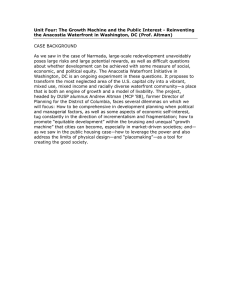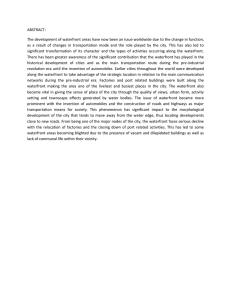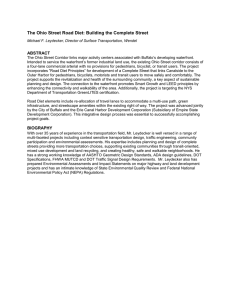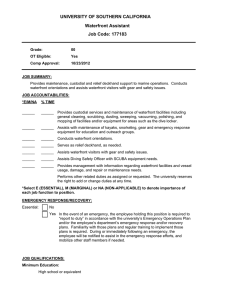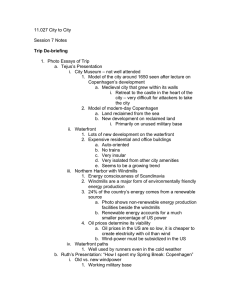Waterfront Vitality Evaluation in Suzhou: A Research Article
advertisement
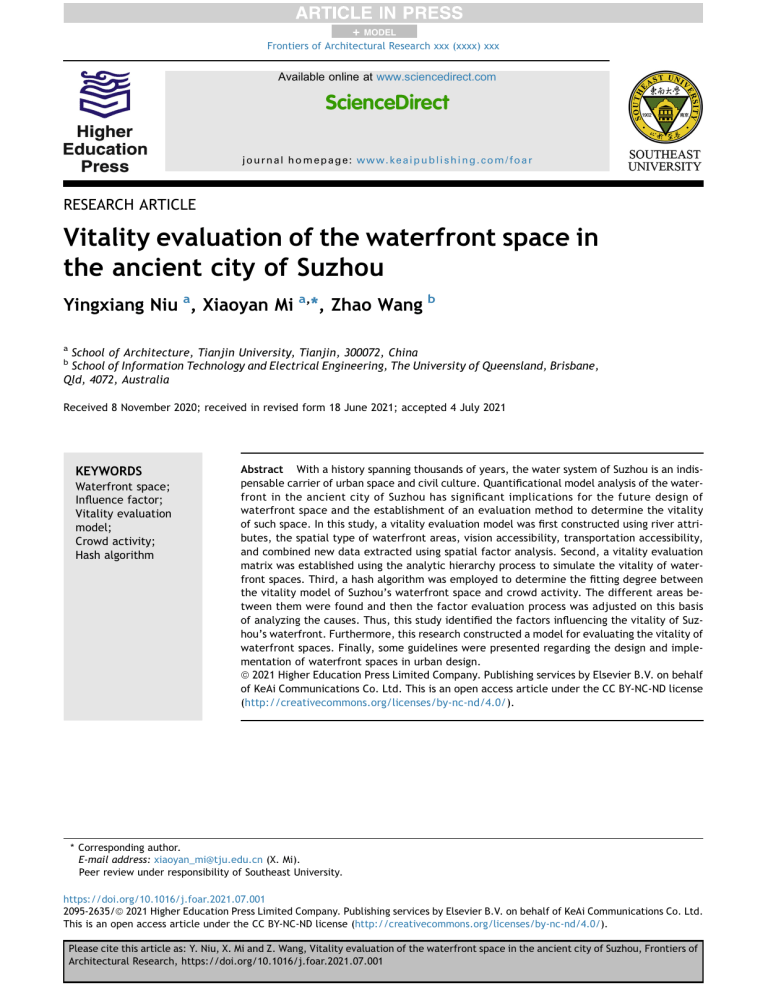
+ MODEL Frontiers of Architectural Research xxx (xxxx) xxx Available online at www.sciencedirect.com ScienceDirect journal homepage: www.keaipublishing.com/foar RESEARCH ARTICLE Vitality evaluation of the waterfront space in the ancient city of Suzhou Yingxiang Niu a, Xiaoyan Mi a,*, Zhao Wang b a School of Architecture, Tianjin University, Tianjin, 300072, China School of Information Technology and Electrical Engineering, The University of Queensland, Brisbane, Qld, 4072, Australia b Received 8 November 2020; received in revised form 18 June 2021; accepted 4 July 2021 KEYWORDS Waterfront space; Influence factor; Vitality evaluation model; Crowd activity; Hash algorithm Abstract With a history spanning thousands of years, the water system of Suzhou is an indispensable carrier of urban space and civil culture. Quantificational model analysis of the waterfront in the ancient city of Suzhou has significant implications for the future design of waterfront space and the establishment of an evaluation method to determine the vitality of such space. In this study, a vitality evaluation model was first constructed using river attributes, the spatial type of waterfront areas, vision accessibility, transportation accessibility, and combined new data extracted using spatial factor analysis. Second, a vitality evaluation matrix was established using the analytic hierarchy process to simulate the vitality of waterfront spaces. Third, a hash algorithm was employed to determine the fitting degree between the vitality model of Suzhou’s waterfront space and crowd activity. The different areas between them were found and then the factor evaluation process was adjusted on this basis of analyzing the causes. Thus, this study identified the factors influencing the vitality of Suzhou’s waterfront. Furthermore, this research constructed a model for evaluating the vitality of waterfront spaces. Finally, some guidelines were presented regarding the design and implementation of waterfront spaces in urban design. ª 2021 Higher Education Press Limited Company. Publishing services by Elsevier B.V. on behalf of KeAi Communications Co. Ltd. This is an open access article under the CC BY-NC-ND license (http://creativecommons.org/licenses/by-nc-nd/4.0/). * Corresponding author. E-mail address: xiaoyan_mi@tju.edu.cn (X. Mi). Peer review under responsibility of Southeast University. https://doi.org/10.1016/j.foar.2021.07.001 2095-2635/ª 2021 Higher Education Press Limited Company. Publishing services by Elsevier B.V. on behalf of KeAi Communications Co. Ltd. This is an open access article under the CC BY-NC-ND license (http://creativecommons.org/licenses/by-nc-nd/4.0/). Please cite this article as: Y. Niu, X. Mi and Z. Wang, Vitality evaluation of the waterfront space in the ancient city of Suzhou, Frontiers of Architectural Research, https://doi.org/10.1016/j.foar.2021.07.001 + MODEL Y. Niu, X. Mi and Z. Wang 1. Introduction through fitting degree analysis of residents’ use efficiency. Moreover, the factors influencing waterfront space vitality in the ancient city of Suzhou and the degrees of influence are clarified. A quantitative model for the waterfront space vitality of the historical water system is constructed. Furthermore, this study proposes a reasonable argumentation and verification method and quantitative data support for the empirical research on waterfront space vitality. With rich water networks and a history of thousands of years, Suzhou is known as the “Oriental Venice.” Waterfront spaces such as lakesides and riversides play a critical role in urban spaces. They not only constitute a natural ecological transition between water and land to improve urban environments and enrich urban landscapes but also foster a close connection between nature and urban crowds to improve urban spatial quality and characteristics. A quantitative evaluation of waterfront space vitality is of great significance in the creation of a healthy social life among urban residents, to the efficient design and renewal of urban spaces, and to the effective allocation and improvement of service facilities for the urban public. In recent years, following the emergence of various new types of data and on the basis of traditional research methods (Yin, 2019), numerous studies have measured the vitality of urban spaces using urban planning and research methods pertaining to sociology and geography (Yang and Shao, 2018). These studies have focused on a certain type of urban space, including residential areas, streets, parks, and scenic spots, to examine the impact of one or several types of elements pertaining to space vitality. Many of the studies have examined waterfront space vitality through methods such as employing the plot ratio as the evaluation standard of development intensity to examine the influence mode and the degree of development intensity with regard to waterfront space vitality (Zhang and Guo, 2019). Furthermore, some scholars have used the characteristics of certain elements to measure the vitality of waterfront space through processes such as measuring the level of shoreline accessibility by taking into account the number of adjacent shoreline roads and road intersections (Zhang, 2018). The density of road intersections within each waterfront space unit was used to measure block texture (Yang et al., 2018), and the distribution of public service facilities within a waterfront space was measured using the density of these facilities (Wang and Ma, 2020). Location centrality was measured by the shortest linear distance between the waterfront space and city center (Chu, 2002). Furthermore, researchers have examined the influence of factors such as shoreline accessibility, block texture, and location centrality on waterfront spaces. The majority of studies have highlighted distinct factors, directly or indirectly analyzing their influence on waterfront space vitality. Therefore, researchers should develop a comprehensive research model to determine the types and levels of the factors that influence waterfront space vitality. This research is based on the relationship between the historical water system and modern social life in the ancient city of Suzhou. Influencing factors are selected from the perspectives of physical space and crowd perception. Drawing from previous research, the current study contributes to the analysis of physical space elements such as river attributes and street types and explores the influencing factors of three-dimensional spaces, such as visual accessibility. Furthermore, it establishes an evaluation model for analyzing the vitality of waterfront spaces based on urban planning and sociological research methods and uses a hash algorithm to demonstrate the rationality of the model 2. Analysis of the spatial characteristics of the waterfront in the ancient city of Suzhou 2.1. The study’s definition of waterfront space Waterfronts constitute a broad concept, covering multiple categories of spaces, including riversides, lakesides, coastal areas, and wetland. The waterfront spaces examined in this research were urban waterfront spaces, which is “a general term for a certain area connected by land and water in a city” that is generally formed by water areas, water boundaries, and land areas (Yang et al., 2018). In line with the scope of this researchdthe actual situation of the waterfront space in Suzhoudthe current study defines waterfront space as the land space within 60 m of a waterfront. 2.2. Characteristics of the waterfront space in Suzhou The water system in Suzhou originated from the Grand Canal of the Suzhou Section. A complete water system network has been created following the flow of water into the urban area of Suzhou. At present, the chessboard pattern observed in the Pingjiang Tu region of the Song Dynasty has been maintained. Overall, Suzhou has a system of water flowing around buildings and is surrounded by the water system. Suzhou’s buildings are mostly located along the rivers, resulting in a waterfront space that is mostly parallel to the rivers. A characteristic waterfront pattern constituting adjacent rivers, land, and streets has thus been formed (Fig. 1; Li et al., 2014). This unique waterfront space serves as the main line of the urban space that connects streets, markets, and other major open spaces. The rivers in Suzhou stretch for 35 km in total, and more than 20 rivers and 180 bridges can be found in the city (Lu, 2016). The ancient city’s water network is divided into three levels: the moat, the trunk river system, and tributaries (Zhang, 2016). The moat forms a ring, and the trunk river system comprises three vertical and three horizontal forms. The tributaries connect the trunk river system to the network, in turn connecting thousands of households. 3. Establishment of a vitality evaluation model for Suzhou’s waterfront 3.1. Selection of vitality-influencing elements and hierarchical structure model establishment Highly concentrated crowd activity in an urban space is a critical manifestation of city vitality (Yin, 2019), which is 2 + MODEL Frontiers of Architectural Research xxx (xxxx) xxx Fig. 1 Schematic map of waterfront space pattern. (a) Source: Self-painted by author based on Pingjiang Map (Song Dynasty). (b) Source: Self-painted by author based on Gusu City Map (Qing Dynasty). (c) Source: Self-painted by author. analysis results. However, this paper mainly studies the influencing factors of waterfront space vitality from the perspective of the surrounding environment without paying attention to the influence of factors such as river attributes and spatial type. On the other hand, it was found that the control and guiding elements of waterfront space included building retreat, waterfront footpath layout, revetment form, dock settings and rail form by consulting the Urban Design Guidelines of Suzhou City (2019). Therefore, on the basis of a systematic review of previous literature and relevant design guidelines, this study selected the influencing factors of waterfront space vitality in Suzhou and summarized different dimensions combined with relevant expert consultation to establish a systematic evaluation system of waterfront space vitality. The influencing factors of waterfront space vitality were finally summarized into multiple dimensions such as traffic, location, building, land use, facilities, waterbody and riverbank. Combined with field research of the spatial characteristics, crowd activities and actual use of the ancient city of Suzhou, the transportation accessibility was used to measure the traffic and location factors of the waterfront space. In view of the building density and development intensity in the ancient city is relatively average, the land use functions and facilities distribution were summarized as functional mixing degree. The water body was summarized as river attributes. The relationship among the waterfront space, adjacent buildings and roads was summarized into three spatial types to reflect the combination type of waterfront space and hydrophilicity of riverbank. Considering the influence of three-dimensional space elements, visual accessibility was added as an influencing factor. Finally, the first-level indicators of waterfront space vitality in Suzhou were summarized into functional type, river attributes, land spatial types, vision accessibility and traffic accessibility. On this basis, the first-level indicators were refined. Through the analysis of the architectural type and land use function of the waterfront space in Suzhou, the functional type was subdivided into education (referring to schools, research institutions and training institutions, etc.), health care (referring to hospitals, pharmacies, clinics, healthcare institutions, etc.), daily life (referring to daily life service places, such as beauty and hair salons, express delivery sites, intermediary agencies, telecom offices, laundry, maintenance sites, printing among the important criteria for measuring the quality of an urban space. This research analyzed the characteristics of the vitality of waterfront spaces by examining the material space representation of crowd concentration and proposed a quantitative evaluation model of this vitality. In this study, it is found that there are few literatures related to the analysis of waterfront space vitality by referring to related keywords in the CNKI and SCI database in the past ten years. The previous literature mainly focused on the influence of single elements such as greenway (Qian et al., 2017), public space (Yang and Shao, 2018) and terrain (Dong et al., 2020) on waterfront space vitality or explored the indirect vitality factors such as publicity (Wang et al., 2020) and connectivity (Da, 2013) of waterfront space. Overall, there are few studies on the systematic construction of the waterfront space vitality influencing system. In addition, the data sources of these studies are mostly questionnaires or field observations, which have no reference significance in the study of largescale urban waterfront space. Among them, Fang Qian decomposed the components of urban waterfront space from the perspective of health orientation (Qian, 2010). Moreover, the study screened out the influencing factors of waterfront space such as traffic, water bodies, greening and activity facilities from its theoretical analysis results. However, this paper mainly focused on the components of waterfront space without paid attention to the land use types and building functions adjacent to the waterfront space. Ting Da indirectly explored the influencing factors of the urban waterfront space vitality from the perspective of influencing the waterfront space connectivity and established the evaluation system of waterfront connectivity with the connectivity calculation method (Da, 2013). The study screened out the influencing factors of the waterfront space vitality including transportation, open space, housing, shopping, sports facilities and other types of POI. However, there is a lack of research on river attributes and vision accessibility in three-dimensional space. Weiqiang Wang et al. introduced the quantitative method to explore he influence of hinterland area development on the vitality of waterfront public space with the help of multi-source data such as microblog, aerial image, population distribution and facility distribution (Wang and Ma, 2020). Moreover, the influence factors such as surrounding facilities mixing degree and surrounding housing were screened out based on the 3 + MODEL Y. Niu, X. Mi and Z. Wang related to vitality. River attributes were subdivided into water width, water depth and water quality. The spatial types were subdivided into no street type, street type (pedestrian) and street type (vehicle) combined with field research on the street types of waterfront space in Suzhou. Traffic accessibility was divided into non-motorized transportation accessibility, mass transit accessibility and private car accessibility through the analysis of crowd travel modes. Finally, according to the selected influencing factors and the logically structured relationships among them, a waterfront space vitality evaluation model comprising 3 levels and 19 factors was established (Fig. 2). 3.2. Weight calculation of the influencing factors through the analytic hierarchy process This study aimed at establishing a vitality evaluation matrix of the waterfront space in Suzhou. The influencing factors of the waterfront space vitality had obvious hierarchies and the relationship between the hierarchies was top-down. In addition, the factors of both the same and the adjacent levels were independent without interdependence and mutual dominance relationship. Therefore, analytic hierarchy process was chosen for weight assignment of influencing factors rather than other methods. In the analytic hierarchy process, the research object is considered as a system and decisions are made by means of decomposition, comparative judgment, and comprehensive thinking (Wang et al., 2018). This process constitutes an organic combination of qualitative and quantitative methods. Furthermore, decision-making problems are transformed using multiple factors that are difficult to quantify into a multilevel and single-objective problem. Fig. 2 Hierarchical structure model of the waterfront space vitality in Suzhou. Source: Self-painted by author. shops), housing (referring to ordinary residence, villa, business residence, etc.), shopping (referring to shopping places, such as shopping malls, stores, convenience stores, vegetable markets), catering (referring to various restaurants, beverage shops, pastry shops, fast food restaurants, etc. that exist independently and open to the outside), sport (referring to sports venues; fitness centers, etc.), landscape (referring to scenic spots), open space (referring to square and green spaces, etc.) and hotel (referring to places that include accommodation functions) highly Table 1 Weights of the influencing factors. Target layer Criterion layer Weight Factor layer Weight Spatial vitality evaluation of the waterfront in the ancient city of Suzhou Functional Mixing Degree 0.2029 River Attributes 0.3018 Land Spatial Type 0.1477 Vision Accessibility Transportation Accessibility 0.0892 0.2583 Education Health care Daily life Housing Shopping Catering Sport Landscape Hotel Open space Water Width Water Depth Water Quality No Street Street (Pedestrian) Street (Vehicle) Vision Accessibility Non-motorized Transportation Accessibility Mass Transit Accessibility Private Car Accessibility 0.0086 0.0111 0.0252 0.009 0.0243 0.0261 0.0089 0.0365 0.0171 0.0362 0.0892 0.0756 0.0337 0.0182 0.0991 0.0304 0.0892 0.1707 4 0.0648 0.0228 + MODEL Frontiers of Architectural Research xxx (xxxx) xxx hierarchy process. The relative importance of each element was determined by comparing all element pairs and using the method of expert group judgment. Expert group judgment was employed to overcome the limitation of subjective factors. When constructing a judgment matrix, the judgment matrix of the criterion layer was first constructed, following which the judgment matrices for the factor layers under each criterion layer were constructed. In the judgment matrix, a comparison scale from 1 to 9 was used to determine the relative importance of each factor and combine the experts’ overall ranking of the relative importance of the various factors influencing waterfront space vitality in Suzhou. Thereafter, the overall order of the relative importance of the influencing factors was determined using the group judgment method, and the weight of each influencing factor was determined based on this determination. The study sent out questionnaires to 30 experts, including 20 local urban planning engineers who had participated in compiling the urban design guidelines of Suzhou and 10 environmental behavioral experts. A total of 30 questionnaires were distributed and received. After analysis and calculation, the consistency ratio of 28 questionnaires was less than 0.1, which met the one-time test and was considered as valid questionnaires. Based on the statistical analysis of 28 valid questionnaire data, the weight of each factor in criterion layer and factor layer was obtained. The specific values are shown in Table 1. The vitality evaluation model for Suzhou’s waterfront space was constructed as follows formulas: Fig. 3 Data process flow diagram. Source: Self-painted by author. The impact of each element on the result is quantified by comparing all element pairs. The study’s evaluation model was based on the hierarchical structure model constructed using the analytic Fig. 4 Distribution map of the functional mixing degree. Source: Self-painted by author. 5 + MODEL Y. Niu, X. Mi and Z. Wang Table 2 Statistics of the river attributes. River name Water quality (type) Water width (m) River name Water quality (type) Water width (m) The first straight River The second straight River The third straight River The first horizontal River The second horizontal River The third horizontal River Lvmenneicheng River Cangqiaobang River Pingmen River Zhongshi River Beiyuan River Xiqilin River V IV IV IV V V IV IV IV IV IV IV 5 3~10 5~6 5~6 5 5~6 6~8 4 4~4.5 4~5 4 4 Huxiangshi River Liuzhi River Xuanqiao River Xinqiao River Loumenneicheng River Dongyuananqu River Panmenneicheng River Zhuhui River Xuejia River Miaojiabang River Moat IV IV IV IV IV IV V V V V V 6 5~6.6 1.8 5 4 4 10~12 6~8 6 5 30~100 Transportation Accessibility Z 0.1707 Non-motorized Transportation Accessibility þ 0.0648 Mass Transit Accessibilityþ0.0228 Private Car Accessibility (5) Waterfront Space Vitality Z 0.2029 Functional Mixing Degree þ 0.3018 River Attributes þ 0.477 Land Spatial Type þ 0.0892 Vision Accessibility þ 0.2583 Transportation Accessibility. (1) 3.3. Classified calculation of the factors influencing waterfront space vitality in Suzhou Among the above factors, the following relationships were observed. To clarify the waterfront space vitality in Suzhou, the influencing factors were classified and calculated. The waterfront space function utilized Baidu map open data, that is, POI data. The water width, depth, and quality data of the waterfront space were collected from the website of the Suzhou Municipal Government and through field research. Street type data were collected through field research and visual and transportation accessibility was calculated and analyzed using Suzhou urban road network data. In this study, all types of data were imported into the ArcGIS platform for data preprocessing, and the preliminary Functional Mixing Degree Z 0.0086 Education þ 0.0111 Health Care þ 0.0252 Daily Life þ 0.0090 Housing þ 0.0243 Shopping þ 0.0261 Catering þ 0.0089 Sport þ 0.0365 Landscape þ 0.0171 Hotel þ 0.0362 Open Space (2) River Attributes Z 0.0756 Water Width þ 0.0337 Water depth þ 0.1925 Water Quality (3) Land Spatial Type Z 0.0182 No Street Type þ 0.0991 Street Type (Pedestrian) þ 0.0304 Street Type (Vehicle)(4) Fig. 5 Comprehensive evaluation of the river attributes. Source: Self-painted by author. 6 + MODEL Frontiers of Architectural Research xxx (xxxx) xxx data results were obtained for subsequent research. Fig. 3 illustrates the specific processing flow. 3.3.1. Function type analysis of Suzhou’s waterfront space Using the ArcGIS platform, the kernel density of 10 types of point of interest (abbreviated as POI in the following) data that were highly correlated with waterfront space vitality in Suzhou and its surrounding area was analyzed (Fig. 4(a)). Each type of POI data was superimposed according to formula (2) through the analytic hierarchy process to create a comprehensive evaluation map of the waterfront spatial function mixing degree in Suzhou (Fig. 4(b)). The comprehensive evaluation map revealed that the place with the highest degree of functional mixing in Suzhou was the middle part of the Xinkai River, followed by the historical and cultural blocks of Pingjiang Road, the west section of the Daoqian River, and the areas around the Zhongshi River. These areas are rich in types and numbers of POI. Furthermore, the various service facilities in these areas are relatively concentrated and fully functional. 3.3.2. River attributes analysis The river attributes were analyzed to obtain statistics pertaining to the water depth, width, and quality data and to calculate basic data as per the quantitative standard assignment calculation. The river attributes were analyzed and calculated according to formula (3), and depth, and the calculation results were visualized through the ArcGIS platform. The average water depth of the moat was 2.8 m, and the water depth was approximately 2.5 m during the dry season (Lu, 2016). The average water depth of the moat was 2.8 m, and the water depth was approximately 2.5 m during the dry season. Considerable siltation was present in the tributaries, the average water depth of which was 1e2 m. As per the quantitative standard, each river was graded based on its depth; that is, 0e2 m was assigned 1 point, and >2 m was attributed 2 points. The water width was calculated from the relevant data and literature (Lu, 2016). Table 2 presents the calculated width of each river in Suzhou. Each river was graded according to its width as per the quantitative standard; that is, 0e10 m was assigned 1 point; 10e30 m was assigned 2 points; and >30 m was assigned 3 points. Water quality information for each river in Suzhou was obtained by considering the average water quality at each observation point in a week (Table 2) from the website of the Suzhou Environmental Protection Bureau and relevant documents (Li et al., 2014). Each river was graded according to water quality as follows: fifth grade water quality was assigned 1 point and fourth grade water quality was assigned 2 points. The weights of water quality, water width and water depth were obtained using the analytic hierarchy process. Fig. 5 presents the comprehensive evaluation results. Finally, the ArcGIS platform was employed to visualize the comprehensive evaluation results of river attributes (Fig. 6). Fig. 6 Distribution map of the river attributes. Source: Selfpainted by author. type, pedestrian street type, and vehicle street type. The spatial sequence of the pedestrian street type was riveresidewalkebuilding, and that of the vehicle street type (vehicle) was riverecarriagewayebuilding. The spatial sequence of no street type was riverebuilding. 3.3.3. Land spatial type analysis Field research and relevant literature review (Zhang, 2016) highlighted three river space types in Suzhou: no street Fig. 7 Distribution map of the space types. Source: Selfpainted by author. 7 + MODEL Y. Niu, X. Mi and Z. Wang waterfront space and size of the surrounding open space. The areas with better sight were found to be concentrated along the moat and on both sides of Ganjiang road; the other river channels had poor sight because the river in these areas is narrower and the surrounding buildings are dense. The comprehensive spatial type analysis map demonstrated that the majority of the water system in Nanyuan was of the no street type. The Pingjiang River system primarily comprised the river and street types, whereas the second Henghe River and Suzhou University water system were mostly of the street type. On the basis of the influence of different land spatial types on waterfront space and accessibility, the influence weights of the three street types were determined through expert marking. Considering this weights as the quantification standard, this study analyzed the waterfront space spatial types in Suzhou according to formula (4) and visualized the calculation results using the ArcGIS platform (Fig. 7). 3.3.5. Classification analysis of waterfront space traffic accessibility The main modes of transportation in Suzhou are nonmotorized transportation (including walking, bicycles, rickshaws and two-wheeler, etc.), private cars, and mass transit (buses and subways). Therefore, the transportation accessibility of the city’s waterfront space was comprehensively analyzed using the ArcGIS platform from the following three aspects: non-motorized transportation accessibility, private car accessibility, and mass transit accessibility (Fig. 9(a)). Non-motorized transportation accessibility was calculated by constructing Suzhou’s road network and employing the origin-destination (abbreviated as OD in the following) cost matrix to calculate the accessibility from each point on the road network to the riverside 3.3.4. Analysis of the vision accessibility of the waterfront space By constructing the raster data topography of Suzhou and the viewing routes along the river, observation points were selected along the routes to analyze the vision accessibility of the waterfront space. As illustrated in Fig. 8, the comprehensive analysis map of vision accessibility indicated that the sight was mainly affected by the width of the Fig. 8 Distribution map of the vision accessibility. Source: Self-painted by author. 8 + MODEL Frontiers of Architectural Research xxx (xxxx) xxx Fig. 9 Distribution map of the transportation accessibility. (a) Classification analysis of transportation accessibility. (b) Comprehensive analysis of transportation accessibility. Source: Self-painted by author. visualized through the ArcGIS platform (Fig. 10). The overall vitality of the waterfront space in Suzhou was found to be relatively high; however, the vitality values of the waterfront spaces in different regions were discovered to be relatively different, as reflected by Guanqian Street in the middle of the Xinkai River, the Pingjiang River, and the western section of the Daoqian River. The Lumen Inner City River and north section of the Xueshi River were observed to be highly active. However, the waterfront space surrounding the moat was found to have relatively low vitality. roads. The accessibility of private cars was calculated to set the capacity values for different roads. Mass transit accessibility was calculated by adding bus stations, subway stations, and subway lines on the road network and by using the OD cost matrix to calculate the accessibility of each bus station, subway station in the ancient city to the subway stations, and the bus stations along the riverside road. The comprehensive evaluation map of the waterfront space’s traffic accessibility was created by superimposing the different weights according to formula (5). The map (Fig. 9(b)) demonstrated that the intersection of the old city center with the north area had relatively high traffic accessibility, whereas that of the southern residential area with the northeast area was relatively low. 4. Analysis of the fitting degree of waterfront space vitality in Suzhou 3.4. Comprehensive analysis of waterfront space vitality in Suzhou By establishing the vitality model of Suzhou’s waterfront space, quantitative analysis of the use of this space was conducted from the perspective of urban analysis. Furthermore, to verify the rationality of the vitality evaluation matrix, the actual data pertaining to crowd activities in the waterfront space were selected for demonstration. Finally, a hash algorithm was used to determine the degree of fit. Then the different areas between them was found and the factor evaluation process was adjusted on this basis of analyzing the causes. On the basis of the classification of influencing factors and their respective weights in the predetermined matrix for waterfront space vitality evaluation, the current study superimposed and calculated the value of waterfront space vitality in Suzhou using the grid calculator in ArcGIS according to formula (1). Fig. 10 displays the vitality of each waterfront space, and the calculation results have been 9 + MODEL Y. Niu, X. Mi and Z. Wang 4.1. Analysis of crowd distribution in Suzhou’s waterfront space This study selected vitality map data from WeChat to examine the crowd distribution in Suzhou’s waterfront space. To ensure high scientific validity of the results, data were collected every 2 h from 6 to 24 points on three days representative of work days, holidays, and weekends, respectively (Guo et al., 2020). Subsequently, the crowd distribution was analyzed for nuclear density; finally, the vitality map data pertaining to 10 periods were superimposed in equal proportion to obtain the waterfront spatial crowd distribution map of the day (Fig. 11(a). (to facilitate comparison, the color and legend digital ranges of the crowd distribution maps in each period were adjusted uniformly). The crowd distribution maps of working days, weekends, and holidays (Fig. 11(a)) were superimposed and analyzed according to the weights determined using the analytic hierarchy process to obtain the actual crowd distribution map in Suzhou (Fig. 11(b)). The crowd distribution map of the waterfront space indicated that the fewest people are present on working days in all three periods, whereas the number of people was highest on the weekends; however, the differences in overall number of people and the size of the trend in the three periods were relatively small. The crowd distribution centers in the three periods were Guanqian Street in the middle section of the Xinkai River, Fig. 10 Comprehensive simulation of the waterfront space vitality. Source: Self-painted by author. Fig. 11 Crowd map of the waterfront space. (a) Crowd distribution analysis of work days, weekends and holidays. (b) Crowd distribution analysis of waterfront space. Source: Self-painted by author. 10 + MODEL Frontiers of Architectural Research xxx (xxxx) xxx Fig. 12 Comparison of the waterfront space vitality evaluation with the crowd distribution. Source: Self-painted by author. process was employed to construct the relevant evaluation system and study the relationship between the influencing factors. Third, the influence mechanism of the various influencing factors on actual commuters of the waterfront space was explored. Fourth, a crowd distribution map of the waterfront space was constructed, and a hash algorithm and the vitality evaluation model were employed to analyze the degree of fit between the evaluation results and actual crowd distribution. A high degree of fit was discovered, verifying the rationality of the evaluation model. 1. This study established a quantitative model for evaluating waterfront space vitality based on historical water systems; this model was, in turn, employed to determine the types and levels of factors that influenced waterfront space vitality. 2. This research led to certain quantitative conclusions on the vitality characteristics of the waterfront space in Suzhou. the Suzhou University area, and the Suzhou Library area. Furthermore, the population was more evenly distributed on working days, and the density at crowd gathering points was higher on weekends and holidays. 4.2. Hash algorithm fitting degree analysis of waterfront space vitality evaluation and crowd distribution A hash algorithm was employed to calculate the fitting degree between the waterfront space vitality evaluation and crowd distribution to verify the rationality of the vitality evaluation model (Fig. 12). A grid with size approximately 1 m 1 m was established with the power of 2, and image similarity was analyzed through Python programming with this accuracy. The fitting degree between the waterfront space vitality evaluation and crowd distribution was concluded to be 95.31%, which is relatively high. In general, the current study’s simulation results of the model for waterfront space vitality evaluation in Suzhou were highly consistent with the actual crowd activity. The weight of each influencing factors in the model can reflect the degree of importance attached to the crowd attraction to waterfront space and can be used as a practical foundation for design and renewal of the city’s waterfront space. First, three types of factors were discovered to influence waterfront space vitality. The functional type of the waterfront space also constitutes the functional mixing degree, and the influencing factors include education, health care, daily life, housing, shopping, catering, sports, landscapes, open spaces, and hotels. Waterfront spatial form elements were river attributes (water width, depth, and quality), spatial types (namely street types: no street type, pedestrian street type, and vehicle street type), and the vision accessibility of the city’s waterfront space. The transportation accessibility of the waterfront space had three factors: nonmotorized transportation accessibility, mass transit accessibility, and private car accessibility. Second, river attributes were discovered to exert the most critical impact on waterfront space vitality in Suzhou, followed by transportation accessibility, functional mixing degree, and land spatial type. Visual accessibility was the least influential factor. 5. Conclusion On the basis of the relationship between historical water systems and modern social life and by using new data, the current study conducted a comprehensive analysis of the function elements, form elements, and transportation elements of Suzhou’s waterfront space to establish a vitality evaluation model of the space from the perspective of material space and crowd perception. First, the factors influencing waterfront space vitality were defined through quantitative analysis. Second, the analytic hierarchy 11 + MODEL Y. Niu, X. Mi and Z. Wang Third, the overall waterfront space vitality in Suzhou was found to be relatively high, and the vitality of the waterfront space in the center was clearly higher than that in the surrounding areas, such as Pingjiang Road, Taohuawu, the second Henghe waterfront space around the Guanqian Street commercial area, and other historical and cultural blocks. The waterfront space vitality around the moat was relatively low, indicating that waterfront space vitality in Suzhou is closely integrated with commercial behavior and historical culture; however, its integration with daily life is weak. Fourth, the waterfront space in areas with higher functional density had higher vitality, such as the waterfront space with sports, catering, and landscape areas. Fifth, transportation accessibility had a strong impact on waterfront space vitality, and a positive correlation existed between them. The street type rivers offer more amenities, leisure facilities, and public spaces; therefore, they have higher vitality compared with no street type rivers. Sixth, visual accessibility was found to have a weak impact on waterfront space vitality, indicating that the waterfront space in Suzhou is not sufficiently hydrophilic, which is a common problem among the waterfront spaces in historical water systems. References Chu, T.J., 2002. Waterfront development abroad and its enlightenment to the development of the Huangpu River in Shanghai. Shanghai Econ. Forum 8, 25e26. Da, T., 2013. Analyses on three-dimensional connectivity of ecosocial function-context of urban waterfront redevelopment. J. Nanjing For. Univ. Forum 3, 129e134. Dong, N.N., Hu, S.H., Chen, L.P., 2020. Terrain design adapted to activity intensity difference of waterfront space: a case study of Houtan Park and Xuhui Riverside. J. Chin. Urban For. Forum 2, 8e14. Guo, H.B., Chen, Y.L., Shao, Y., Kou, W.N., 2020. A study on spatial vitality and mechanism of influence on typical blocks of the old town of Harbin. Arch. J. 2, 114e119. Li, Y.L., Zhang, Y.H., Jia, H.F., 2014. Spatio-temporal characteristics and source identification of water pollutants in ancient town of Suzhou. Acta Sci. Circumstantiae 34, 1032e1044. Lu, F., 2016. River Landscape Quality Analysis and Evaluation of Ancient Suzhou Cityeetaking Ganjang River as an Example. Suzhou University, Suzhou. Qian, C., Wang, D.H., He, Y.J., Shen, S., Hu, T.Y., Yi, X.T., 2017. Primary exploration of study on the correlation between the vitality of waterfront space and the green way. Zhejiang Constr. Forum 5, 1e3þ21. Qian, F., 2010. Analysis of the components of urban waterfront space from the perspective of health orientation. Arch. J. Forum 11, 80e85. Wang, W.Q., Ma, X.J., 2020. Vitality assessment of waterfront public space based on multi-source data: a case study of the Huangpu river waterfront. Urban Plan. Forum 1, 48e56. Wang, L.L., Yuan, W.W., Luo, C., 2020. Research on the publicity of urban waterfront public spaceddA case of waterfront space surrounding Xiamen University. Urban Arch. 17, 92e95þ102. Wang, Y., Zou, Q.Q., Li, G.B., 2018. Public space construction of urban resettlement community based on analysis of vitality characteristics: taking the 6 resettlement communities of Suzhou as examples. Sci. Geogr. Sin. 38, 747e754. Yang, C.X., Shao, B., 2018. Influence of waterfront public space elements on lingering vitality and strategies: taking two typical waterfronts along HuangPu River, Shanghai as examples. Urban. Arch. 5, 40e47. Yang, C.X., Shi, M., Geng, H.Z., 2018. Study on the pedestrian accessibility of waterfront area based on an understanding of urban fabric level: taking the estuary area of Sezhou River in Shanghai as an example. Urban Plan. Forum 42, 104e114. Yin, J.X., 2019. Summary of research methods on urban space vitality. Sichuan Arch. 39, 54e57. Zhang, F., 2016. Analysis and evaluation of river-street space correlation of contemporary towns in south of Yangtze River eeSuzhou as an example. Arch. Cult. 5, 87e89. Zhang, L., 2018. Urban waterfront spatial analytic model under the view of vitality eea case study of Qinhuai River in Nanjing. Southeast University. Zhang, Y., Guo, H., 2019. Study on the evaluation for the vitality of space in urban waterfront based on the concept of healthy city. Design View 26, 79e84. 3. The practical application of the evaluation model for waterfront space vitality is promising. First, the model can clarify the factors influencing urban waterfront space, and quantitative analysis can be performed for waterfront space design. Second, quantitative suggestions can be presented for the optimization of service facilities and restoration of urban waterfront space based on the model. Third, the model can be used to make effective suggestions pertaining to the layout and functional setting of the urban waterfront space. Declaration of competing interest The authors declare that they have no known competing financial interests or personal relationships that could have appeared to influence the work reported in this paper. Acknowledgements This research was supported by the National Natural Science Foundation of China (No.51708398), Beiyang Scholar of Tianjin University (2019XRG-0025) and the National Key Research and Development Program of China (No. 2018YFC0704700). 12
